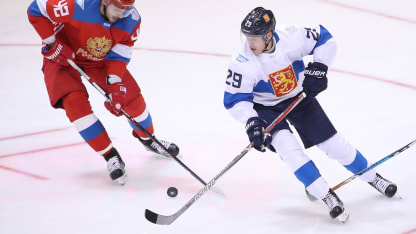When you think of hockey, you think of Canada.
It's the national sport of our northern neighbors, and any mention of hockey in the United States conjures thoughts of kids skating on outdoor ponds in places like Kitchener and Moose Jaw, not to mention sold-out arenas of fans rooting on the maple leaf sweater.
Finland's proud hockey history on display during Blue Jackets' visit
A hockey-mad country welcomes Columbus for a pair of games this upcoming weekend

That's the culture in which Justin Danforth grew up, and like many hockey-crazed kids, he dreamed of wearing an NHL uniform as a kid. His journey took him from Oshawa, Ontario, to college hockey in the United States and pro hockey in Finland and Russia before he finally signed with the Blue Jackets and made his debut last season at age 28.
He took the long road, which also allowed him to see the world. And when Danforth spent two seasons playing with Lukko in Rauma, Finland, he discovered something.
In Finland, just like in his home country, hockey is king.
"It's crazy how big hockey is in Finland," Danforth said. "Hockey is their sport. In Canada, hockey is our sport, but we also have basketball, baseball -- there's a lot of options. When you go to Finland, it's hockey."
Of course, other sports are available and popular in Finland. A Finnish version of baseball known as pesäpallo has a following, and Finns have made it big in basketball (Lauri Markkanen), auto racing (Kimi Raikkonen) and soccer (Sami Hyypia).
But at the end of the day, it's said that the only two countries in the world where hockey is the most popular sport are Canada and Finland. The Nordic country has become a world power, producing such current stars as Aleksander Barkov, Mikko Rantanen, Sebastian Aho and Patrik Laine, not to mention such legendary figures in recent years as Teemu Selanne, the Koivu brothers Saku and Mikko, and iconic goalies Tuukka Rask and Pekka Rinne.
For a nation of just over 5.5 million residents -- half that of Ohio -- it's a tremendous level of success, spurred on by a love of the game and a national pride and determination that allows the country to punch above its perceived weight.
When Laine's Blue Jackets and Rantanen's Colorado Avalanche play in two games in Tampere, Finland, on Friday and Saturday, it will bring the sport's highest level to a country that can't get enough of it.
"It's the No. 1 sport in Finland," Blue Jackets goaltender Joonas Korpisalo said. "Everyone follows hockey. You see it in the magazines. Every game there's highlights. It's really cool. Especially growing up since being young and now playing there, it's really cool."
A Strong Tradition
According to the history books, the first Finnish-born player to make it to the NHL was Albert Pudas, a native of Siikajoki who played in just four games for the Toronto St. Pats -- the precursor to the Maple Leafs -- in 1926. Karijoki native Pentti Lund was the first Finn to make an impact in the NHL, playing in 259 games and amassing 99 points with the Rangers and Bruins from 1949-53.
The SM-Sarja, the original Finnish hockey league, dates all the way back to 1928, and high-level hockey has been played in the country ever since then. Many, in fact, will remember the 1980 U.S. Olympic hockey team didn't win gold with its famed victory against the Soviet Union but still had to beat Finland in the de facto gold medal game to complete the Miracle on Ice.
Yet Finnish players didn't consistently start making their way to the NHL until the mid-1970s. The first true breakout star in North America was Jari Kurri, the first Finnish player to be inducted into the Hockey Hall of Fame, who had 1,398 points (23rd all-time) from 1981-98 and won five Stanley Cups as part of the Edmonton Oilers dynasty.
Ville Siren was born in 1964 in Tampere, which at the time had three top-level professional teams -- current Liiga members Ilves and Tappara as well as Kouvee. He came up through the Ilves system, playing three seasons with the club, before he headed to North America to play with the Pittsburgh Penguins.
Hockey has become more of an international sport -- there have been seasons where the Blue Jackets had up to 10 different nationalities represented on the roster -- but of the top 20 point scorers on the 1985-86 Penguins, 16 were Canadians.
There were two Americans -- defensemen Jim Johnson and Moe Mantha -- plus Swedish forward Willy Lindstrom and Siren.
"When I went to Pittsburgh in the beginning, I was the only European," said Siren, who is now the Blue Jackets director of amateur scouting. "We got (Lindstrom), but in the beginning, I was the only European.
"I was in the second or third wave (of Finns heading to North America to play). It's so much different now. It's not that unusual anymore like in the early '80s. We had not so many playing at that time. I don't know how many we had when I came over, maybe 10 or whatever, but it was not that many."
A Current Boom
While Finland has a strong hockey history, by the late 2000s, there was concern about the declining performance both at the NHL level and with the country's national teams.
The all-time leading NHL scorer among Finns, Selanne became a bona fide legend with Anaheim in the 1990s and early 2000s, and such names as the Koivus, Olli Jokinen, Kimmo Timonen, Jere Lehtinen and Sami Kapanen helped carry the banner throughout that time as well.
But by the late 2000s, Finland was looking at a bit of a crisis when it came to its performance on the ice. In the 2008-09 NHL season, Mikko Koivu (47th) was the only native of the country to finish in the top 75 of the league in scoring, and only two Finns were taken in the first round of the NHL draft in a five-year span from 2005 through 2009.
Add in international struggles -- Finland made it to the gold medal game of the World Championships just once from 2002-09 -- and there was a realization something had to change. A summit hosted by the Finnish Ice Hockey Association and led by longtime Finnish coach Erkka Westerlund came up with a few conclusions to boost the production of talented players in the country, including investing in youth and national team coaching as well as leaning more into the players' individuality.
And it worked. Whereas just 8.8 natives of Finland were taken in the NHL draft on average from 2005-09, that number has jumped to an average of 17.0 in the last eight drafts. In that time, 19 Finns have been selected in the first round.
"I think it starts with the love for the sport, but it's also from the grassroots of coaching and teaching the kids how to play the game," said CBJ general manager Jarmo Kekalainen, who was born in Tampere. "I think there's a strong foundation in Finland in place where there's great coaching within the kids, and that explains why we've had such great success at the World Junior level and the Under-18 World Junior level.
"For such a small country with such a small population, we have a lot of kids playing hockey, but they're also being well-coached, and that's why they become good hockey players."
Internationally, the country has cemented itself as a world power in recent years, earning gold at the 2022 Winter Olympics on the men's side, the first-ever gold medal at the tournament. Three months later, Finland also captured the crown at the IIHF World Championships, its second such title in the past four seasons.
"Two and a half million Finns watched the national team play in the World Championships final, and there's 5.5 million people," Kekalainen said. "I think that pretty much says it all."
Add in victories in the World Junior Championships three times from 2014-19 and the strength of Finland at the international level is a tremendous point of pride for a country that views itself as the scrappy underdog of international hockey -- and celebrates as such.
"That's the biggest thing in Finland is the World Championships and Olympics, in terms of playing hockey," Korpisalo said. "It's so big that I don't think you can even understand it. Every time they win, everyone goes out in the street to celebrate. Everyone is watching the games. It's really cool."
NHL Focus
When Siren first made traveled to Pittsburgh to join the Penguins, there were only so many Finnish players he could lean on for advice about the transition. In fact, it was akin to moving to a new world.
"I didn't know anything about North America," Siren said. "It wasn't easy, but I went through it. You get to know guys, and they took me under their wing. It was good after a while, but I was young and it was my second time in North America when I came over. It was all new -- everything basically."
While more and more Finnish players have made the leap to North America, even someone like Patrik Laine said it was difficult to stay abreast on the NHL when he was a kid growing up in Tampere. A fan of Tappara who grew up going to games at the famous Hakametsä arena in the city, Laine said he didn't have many avenues to watch the game taking place in Canada and the United States.
"Back then, it was so hard to follow the NHL," Laine said. "The internet wasn't what it is today, all the different channels and streams and whatever. It was mostly just highlights on YouTube and that kind of stuff. (I followed) mostly the Finnish league at the time."
That has started to change in recent years, as the NHL has become much more popular, in part because of the influx of Finnish stars. Laine has been one of the drivers of that, as his gold medal-winning 2016 World Juniors team that also featured Sebastian Aho and Jesse Puljujarvi was a sensation in the country, and all have remained popular players as they have established themselves at the NHL level.
"There's an old concept in Finland called text TV, and there's page 235," Kekalainen said. "That's the NHL scores. Every morning, people that still go there the old-fashioned way, that's the first thing they look at. And now with the phones, it's a little bit easier, but yeah, the NHL is huge in Finland and Finnish players are being followed as well."
"We have so many stars already in the NHL, which has raised the level of interest to follow it too," said Saila Sotavalta, a Tampere resident who became a fan of the Blue Jackets because of Laine. "Finnish people are proud of their countrymen doing good in hockey no matter where they play. We have several hockey podcasts, and any league is available to watch if wanted. Finland is very proud of its star players doing well in the NHL, and every newspaper writes stories about them every day."
In other words, having NHL teams featuring such notable Finnish ties playing this weekend will be a spectacle that Finns can't wait to see. For a hockey-mad country, bringing the best in the world for games that count is just another sign of how deep the sport's roots are in Finland -- and how they will continue to grow.
"Hockey has always been No. 1," Siren said. "I think it's even more (now than ever). There is soccer, motorsports and others, but hockey is the most popular sport."

















